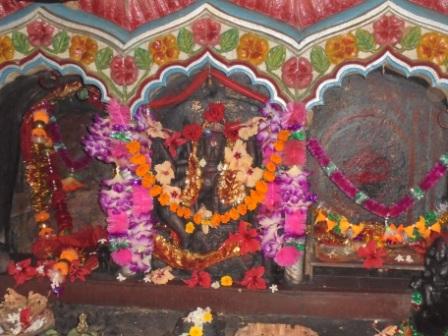Hatadihi: Well known for its rich mineral resources, Keonjhar district is also endowed with scores of scenic places and shrines, though many of them are still unexplored.
Maa Gadachandi temple in Hatadihi block is one of such place. The state tourism department declared it as a tourist centre in 1998.
Significantly, the place has countless archaeological remains around it, but sadly no step has been taken for their conservation, locals alleged.
Besides, no detailed research has been done in the area about these ancient monuments. This is a major handicap in unveiling interesting historical facts about the place.
This place is seated near a beautiful mountain stream. Legend has it that Goddess Gadachandi was worshipped for ages in a cave atop the hill. During the royal regime, Duga Puja was being celebrated here with pomp and gaiety. Buffaloes used to be sacrificed.
According to local legend, one day, a Dehuri priest had gone up the hill to worship the Goddess. After performing puja, he had forgotten to carry back his sharp-edged weapon he had with him to save himself from wild animals.
Later, he went back to the hill and was shocked to find that Goddess was drinking blood. The Goddess was angry at the priest and cast aside his weapon. The Goddess ordered the priest that she will be worshipped at the place where the weapon dropped down. As the weapon dropped at the foothill, the Goddess is being worshipped in a temple there.
Dense forests and the beautiful stream add charm to this place. A visitor has to climb 50 steps to reach the shrine. Towards the middle of the hill lies an ancient cave where Maa Gadachandi was earlier being worshipped.
Many historians related the place to Jain monuments while archaeologists have also unearthed statues of Mahavir Jain near the place.
Moreover, Buddhist historical remnants were also found at many places near the temple. Name of a village Baidakhia might have been originated from Buddha Akshya (tale of Buddha).
The place was earlier known as Shilapur, believed to be a seat of Jainism. In the yore, kings initiated into Jainism and Buddhism used to rule this domain.
Later, kings of Singh dynasty from Rajputana ruled over it.
A ruler of Bhanja dynasty from Keonjhar attacked the Singh rulers. To escape death, the Singh rulers fled the battleground. However, later some guerrilla attackers killed the king. The other members of the family were later shifted to nearby Agarpada.
After the Singh dynasty shifted to Agarpada, the Bhanja rulers of Keonjhar took over the administration of Gadachandi shrine.
Locals said, “The tourism department made Maa Gadachandi temple a tourist site in 1998, but no step was taken to carry out detailed excavation of any historical site here to explore more facts. Infrastructure development for the site is also not progressing adequately as planned.’’
The place is at the foothills of the famous Baula range and about 97 km away from Keonjhar town. People coming from Anandapur and Bhadrak side will have to move on the NH-215 and then to take the road to Hadagada elephant reserve from Anandapur. Then, they have to move about 10km from Chhenapadi Square to reach the place.
The Gadachandi shrine is surrounded by many famous tourist destinations such as the Hadagada elephant reserve, Hadagada dam and a dense forest range on the north. On its east are Bidyadharpur barrage and Maa Chakariasuni shrine.
Visitors usually throng the temple during Makar Sankranti and Durga Puja.
PNN
